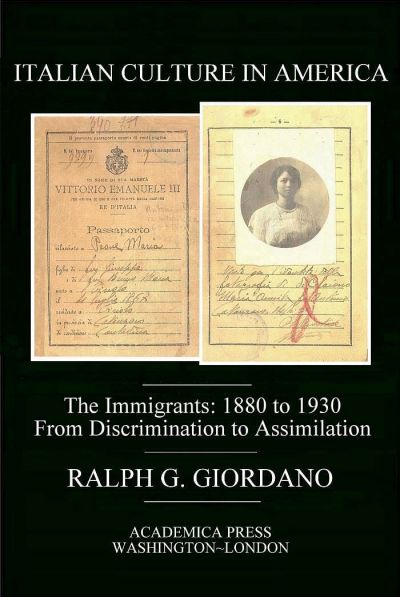The history of Italians in America began more than 500 years ago with a Genoese sailor who bumped into uncharted land. Within 35 years, three other explorers, all of Italian heritage, would chart land for England, Spain, Portugal, and France. From their explorations, a new world map was formed and the new continent beckoned a wide dispersal and intermingling of cultures.
Ninety-five years after Verrazzano’s exploration (in 1524) of the eastern coast, of what would become the United States, the first Italian immigrants arrived. From the early 1600s to the mid-1800s, Italians immigrated at a slow, but somewhat steady pace. By the late 1800s, the steady pace had rapidly accelerated.
In “Italian Culture in America: The Immigrants 1880 to 1930, From Discrimination to Assimilation,” author Ralph G. Giordano provides a thorough look into Italian American history. The Introduction presents a broad overview of how Italian American culture is woven into American society. He writes, “As history has often obscured the abundance of the multitude of varied contributions of Italians to all aspects of cultural development in America, a continuing disparaging image has buried the overwhelming positive attainment behind the negative.” Essentially, Italian American history suffers from a deficiency of lesson plans and an abundance of negative media hype.
Each chapter in the book is comprised of different segments of Italian American culture, and shows the history related to that slice of the compendium. For example, in chapter seven, “Birth of American Vaudeville and Show Business,” Ralph notes: “The rise of American vaudeville in the mid-19th century had its roots in the 16th century Italian ‘Commedia dell’arte,’ literal translation is ‘Art Comedy.’” The influence of Italian culture on American entertainment is so expansive, chapter seven is divided into four supplementary chapters: “Italian Opera and Enrico Caruso,” “Jazz and Italian Origins,” “California and Texas (Here They Come),” and “Italians in Hollywood and Rudolph Valentino.”
California is noted for the influx of Italian immigrants because of their attraction to its physical characteristics: “similar to Italy with a long narrow geographical diverse area with a coastline almost 1,200 miles ...” and “the pleasant climatic conditions conducive for quality wine production.” In addition to numerous Italian wineries, “By the first decade of the 20th century, Italians introduced bell peppers, artichokes, eggplants, and broccoli to the California farms.” More notable is A.P. Giannini, who worked in the family’s produce business as a teen, and after establishing a career as a banker, funded numerous entertainment, construction, and business projects.
In Texas, the winery founded by an Italian immigrant in 1883, is in its fourth generation of family ownership. From Ralph: “Buoyed by the Val Verde Italian winery, by the 21st century over 350 Texas wineries were in operation.” Showmanship could be attributed to both Salvatore Lucchese and Tony Lama. Each began their iconic status as boot makers in the leather trade industry in Texas.
In chapter one, Ralph describes how nationalism and the Industrial Revolution affected immigration in the late 19th century, the importance of Christopher Columbus in American and Italian American history, and how Italy “is not easily as defined as the other nations of Europe or the world.” Each of its 20 regions “maintained a sense of self-sufficiency with minimal reliance, or even basic trust, with the other regions.” This explains much about the Italian American mindset, as well as why although assimilated, Italian American ethnicity is, many times, looked upon with disdain and often ridiculed.
Chapter three “Anti-Immigration, Discriminating, and Lynching,” details how “Situations involving violence increased against Italian immigrants,” and subsequent chapters point out the barriers the immigrants faced in housing, work, religion, family and social life. Having a deeper understanding of an ethnic group’s cultural history leads to respect for their heritage, and Ralph has provided an in-depth analysis of the Italian immigrants’ life-changing transformation into Italian Americans.
Although academic in content, the book is written for the general public, bypassing the often-ostentatious tone of scholarly works. Each chapter is divided into numerous single-topic sections, clearly defined by subheadings and an abundance of illustrations enhance the text. An extensive bibliography provides the resources for the facts presented and the detailed index is comparative to an encyclopedia of Italian American history. Several have been published, but “Italian Culture in America: The Immigrants 1880 to 1930, From Discrimination to Assimilation” is the most recent by almost 10 years, focusing on a crucial era of Italian American history and how the integration of Italian culture has transformed present-day American society.
For the classroom, and public or home library, “Italian Culture in America: The Immigrants 1880 to 1930, From Discrimination to Assimilation” educates readers about the Italian immigrants’ experiences as they migrated from Italy to America. In his Introduction, Ralph quotes acclaimed art historian Irma B. Jaffe: “It would be impossible to overstate the debt of insight and inspiration that the Western world owes to Italian culture.”



